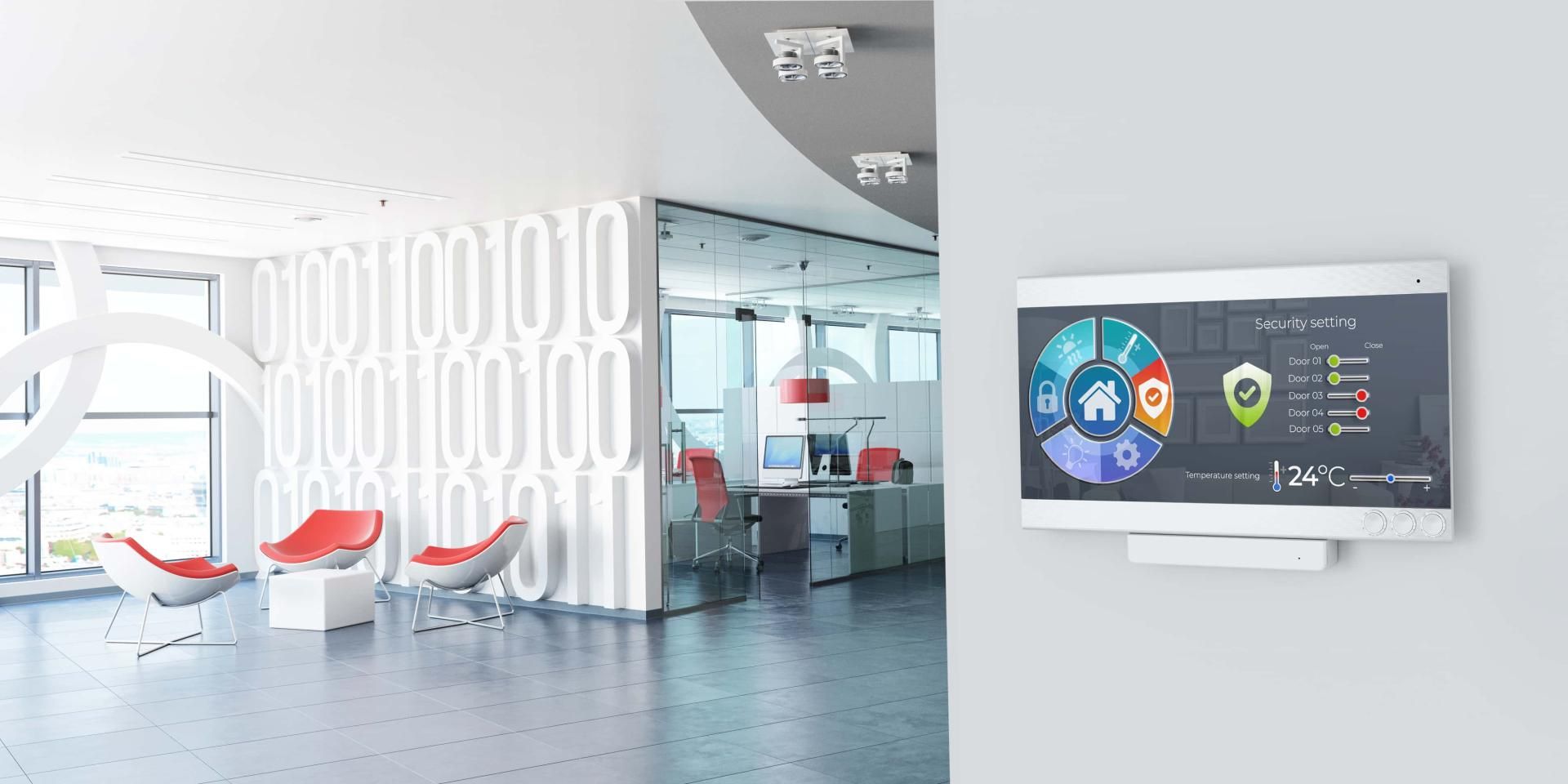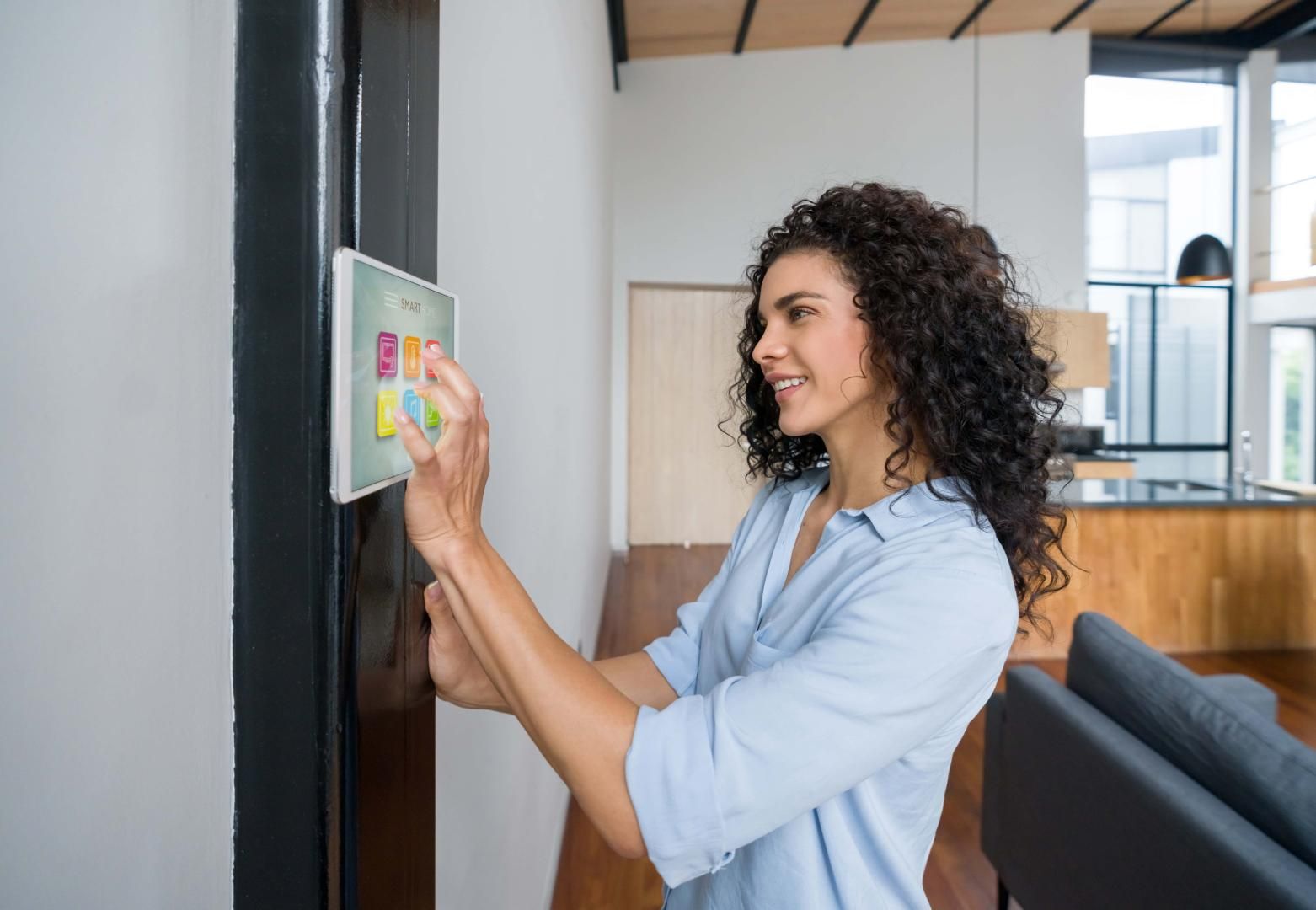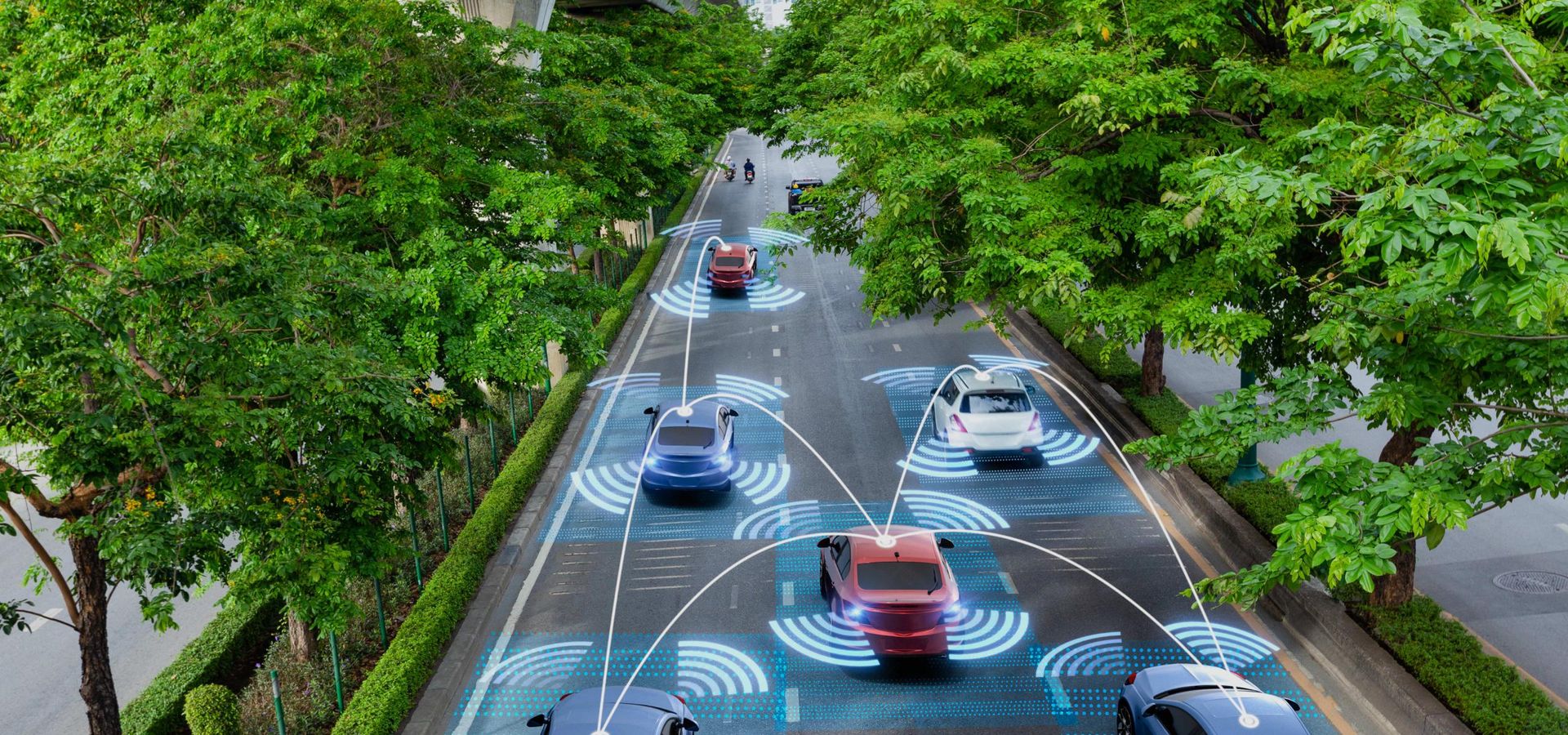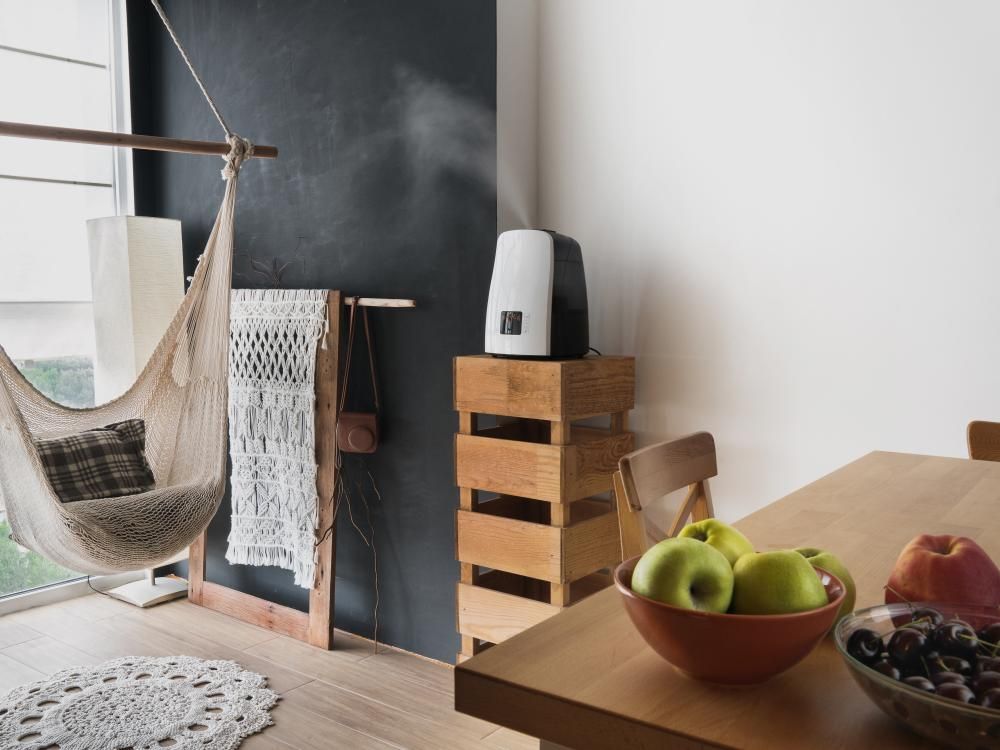
IoT home automation: 7 use cases, technologies & examples
November 21, 2023

by Ilya Katlinsky,
Solution Architect
IoT for smart home automation implies utilizing internet-connected devices with sensors and actuators controlled through a centralized system (e.g., a smartphone) to manage home appliances and automate household routines. Smart home automation allows residents to control lighting, heating, air conditioning, and security from a single point of access.
With 25+ years of experience in software development, Itransition can swiftly integrate IoT technologies into your smart home business, ensuring the safety and security of the implemented solutions.
Internet of Things for home automation: market overview
The global smart home automation market is under the sway of advanced technologies. Still, many people perceive smart homes as a luxurious lifestyle rather than a necessity, so it can be challenging for users to relate the high costs of smart home appliances and their actual necessity. Though on a staggering basis, the market is growing.
$163.7 bn
The expected value of the global smart home market by 2028
Markets and Markets
30.4%
The revenue share of the home security and access control segment
Grand View Research
32.21%
The CAGR of the fastest-growing Asia Pacific segment from 2023 to 2030
Grand View Research
IoT in home automation: real-life examples
IoT solutions for LG
IoT solutions for LG
A home electronic and appliance leader, LG provides its customers with an interactive LG ThinQ application to control refrigerators, laundry machines, air conditioners, and vacuum cleaners. LG IoT products are powered with voice control capabilities, an AI platform, and machine learning technologies. Smart devices can receive voice commands connected with Alexa or Google Assistant.
- Smart refrigerators
With the LG ThinQ refrigerator, users can remotely control its temperature, adjust the speed of the ice maker, get a smart diagnosis of fridge condition, track food in the fridge, and receive alerts on the products’ expiration date or the door left open.
- Smart laundry
Using the ThinQ application, users can start and finish washing cycles remotely, select an optimal washing and drying cycle, and receive notifications on scheduled appliance maintenance.
- Smart air conditioner and humidifier
LG ThinQ enables users to start the device from anywhere, manage and monitor it, and stay informed about indoor air quality using a smartphone.
5G IoT Smart Lock
5G IoT Smart Lock
Digital Keys introduced a smart lock with a cellular connection to ensure additional home security. Homeowners can open the smart lock with a digital keys app, PIN codes, NFC on a mobile phone, and NFC cards, or remotely unlock the door with a mobile app to let the guests in, for example.
The lock can connect to the internet using Wi-Fi or inbuilt SIM cards. Users benefit from real-life tracking of who opens the lock and timely alerts of lock tampering. Digital Keys partners with AWS to store all the smart lock and application data in the cloud.
Smart Lighting from Philips Hue
Smart Lighting from Philips Hue
Philips Hue offers a variety of smart lighting products, from simple smart bulbs to table lamps, floor lamps, wall lights, and light strips. Smart lighting connects to the user’s mobile application via the Philips Hue Bridge system - the brains of the whole lighting system.
Utilizing Zigbee protocols, Philips Hue allows users to control and customize their home lighting from anywhere and schedule the lights to go on and off according to the user’s preferences. Philips Hue lighting connected to a motion sensor can switch on the light when someone enters the room. It can also be connected to Alexa, Google Assistant, Apple Home, and Siri to control lighting with voice commands.

Image Title: Philips Hue smart lighting
Image Source: Philips Hue
Smart Irrigation System from Gardena
Smart Irrigation System from Gardena
Gardena uses smart sensors to measure soil moisture at the required depth (the plant roots or in a flower pot) and sends alerts on the need to irrigate a particular area of your garden.
With a Gardena smart app, users can know the precise amount of the required water supply and access the weather forecast to reconsider the watering schedule of their gardens and save on water bills.
Top 7 IoT use cases in home automation
IoT-powered smart homes bring the house of the future closer to reality. Here are the top use cases of how IoT tech in smart homes is raising the standard of living.
Doors
Temperature control
Windows
Gardens
Lighting
Home routines
Safety sensors
Bathrooms
Security Systems
Kitchen
Apps of IoT in Smart Homes
Lighting
Smart lighting systems provide remote centralized control of all lights in the house, allowing users to set up automatization and switch the lights on or off using a smartphone app. Integration of lighting systems with a smart assistant, like Amazon Alexa or Google Assistant, lets users interact with light bulbs using their voice. For example, the system can be tuned to turn down all the lights automatically when no one is at home. Vice versa, IoT sensors can turn on the lights if they sense that it is too dark in a room. In addition, the lighting systems can follow specific patterns, like dimming the lights in a bedroom after 11 pm or in the dining room when the TV is on.
Benefit
IoT-connected intelligent lighting systems can significantly change how residents perceive their houses, adding much to their comfort and helping save energy and reduce electricity bills.
HVAC
Smart thermostat sensors measure the home’s temperature and humidity and transmit data to heating, ventilation, and air conditioning (HVAC) systems. HVAC systems can maintain the temperature at a comfortable level for all residents. Users can also program HVAC systems to raise the temperature an hour before people return home. Besides, HVAC can automatically adjust the temperature depending on residents’ activities: should a person practice yoga or exercise, the temperature will automatically drop.
Benefit
Smart air conditioning systems increase personal comfort and contribute to energy savings.
Security cameras
Security cameras ensure continuous real-time surveillance of private houses and apartments. They record everything inside and outside the house 24/7 and transmit the data to the cloud. With cameras, users can check in on their pets or elderly people left alone during the day. Should a house be invaded, residents will have a full recording that can be useful to the police.
Benefit
Increased security level for your family members and belongings.
Safety systems
Smart safety sensors can track gas or water pipe leaks and alert users via mobile applications. When the user receives a notification, they can remotely turn the water off at the mainline or call the emergency services to prevent hazardous consequences. Moreover, windows can be equipped with other types of smart sensors to track all the opening and closing actions in the house.
Benefit
Improved home safety with better control of home utilities and windows as well as insurance benefits. Many insurance companies offer IoT technologies and encourage policyholders to use connected devices, offering discounts when the house is equipped with smart security features that prevent fire, water, or gas leaks.
Smart locks
Front doors equipped with smart locks let people indoors not only with standard keys but also with codes, biometrics, or face recognition. Using a connected mobile application, users can let their guests into the house remotely and always stay in the know about all the door-in and door-out movements. Moreover, home residents can connect smart locks to lighting and heating systems to turn on necessary appliances as soon as the door opens.
Benefit
Increased home safety and security, as well as personal comfort.
Smart appliances
With Wi-Fi fridges, microwaves, ovens, and kettles connected to the internet and a mobile app or a home assistant, users can establish remote control over home appliances. The fridge can suggest recipes or shopping lists based on the products inside. With a mobile application, a user can change the refrigerator's temperature and control its technical condition to take preventative measures before it breaks down. Using their voice, home residents can give home assistants tasks to switch on the electric kettle or set the temperature in the oven to a certain degree.
Benefit
Improved home experience, comfort, and convenience, saved personal time, and longer appliances’ lifespan due to predictive maintenance alerts. Technological improvements and increased convenience driven by smart appliances can also increase home value, making IoT-powered smart homes a selling point for potential buyers.
Gardening
Similarly to IoT in agriculture, connected devices can significantly reshape traditional ways of growing vegetables at home. The sensors can monitor the state of the soil, moisture, and sun levels and transmit the data to an application. A connected mobile app can gather data about weather forecasts and trigger irrigation devices.
Benefit
Smart gardening solutions with remote control decrease water waste, improve soil humidity, and enhance harvest quality.
IoT architecture for smart homes
IoT architecture can vary from smart house to smart house, but it still follows a widely accepted general IoT architecture layout.

1 Device level
The device layer encompasses all interconnected smart devices and home appliances with sensors and actuators. The devices include smart lighting, video cameras, kitchen appliances, smart mirrors, air conditioning systems, and smart locks. Depending on the type, sensors catch and transmit the required information to the processing center. Sensors include humidity, motion, temperature, and gate control trackers. Conversely, actuators perform specific actions generated in the processing center on the IoT smart home devices, like switching off a light or turning on the HVAC or the washing machine.
2 Network layer
The network layer includes communication protocols that IoT devices in a smart home use to communicate with each other, cloud storage, and mobile applications. Smart home devices use wireless technologies, such as Wi-Fi or cellular connection (4G/5G) to connect smart devices to the internet and cloud databases, or short-range communication protocols such as Zigbee or Bluetooth, for example, to communicate with each other, or Ethernet to connect with the home router.
3 Edge processing layer
The edge processing layer is not obligatory, but with the advancement of technology, more and more IoT manufacturers include edge computing capabilities in their devices. Edge devices can process the received data from sensors closer to their source without transmitting all the information to the cloud for further processing. Edge computing provides for faster and more cost-efficient IoT device utilization.
4 Cloud data management
Despite the progressive edge computing development, IoT systems require a database for information storage and IoT-driven analytics. The cloud layer organizes vast amounts of data from IoT devices and acts as a central storage and processing hub. It ensures data safety and accessibility for analysis and decision-making.
5 Application layer
At the application level, all the gathered data is presented to the IoT users directly or are processed by IoT data analytics solutions that uncover more in-depth insights from it. IoT solutions for smart homes usually require a mobile application to access IoT-generated data. Users get insights into home conditions and manage smart home devices and appliances.
Want to integrate IoT into your home automation solutions?
IoT cloud platforms we use
When building IoT home automation solutions, we opt for leading cloud platform providers, AWS and Azure, to safely deploy the backend of the IoT apps as well as store and process IoT data.
AWS IoT offers a full suite of services, from effective data processing and analytics to seamless device connection and control.
Data services
- AWS IoT Events for event monitoring
- AWS IoT Analytics for data analysis
- AWS IoT SiteWise to process facility data
- AWS IoT Twin Maker for building digital twins
Control services
- AWS IoT Core for connecting IoT devices
- AWS IoT Device Advisor for device validation
- AWS IoT Device Defender for data security
- AWS IoT Device Management to control IoT devices
Device services
- AWS IoT Device SDK to connect devices to AWS
- AWS IoT ExpressLink to maintain hardware modules
- AWS IoT Device Tester for automated testing
- AWS IoT Greengrass to manage edge devices
Azure IoT offers extensive services, from IoT modeling and edge computing to secure connectivity and SQL Edge deployments.
- Azure IoT Central for accelerating IoT development
- Azure Digital Twins for IoT modeling
- Azure Time Series Insights for data analysis
- Azure RTOS for establishing IoT connectivity
- Azure SQL Edge to enable IoT and IoT Edge deployments
- Azure IoT Edge to offload AI and analytics workloads to the edge
- Azure Sphere for connecting MCU-powered devices
- Azure IoT Hub for secure device management
IoT adoption challenges & solutions
Despite the many benefits IoT home automation can bring, several challenges still impede the widespread adoption of smart home technologies.
Challenge
Solution
Data privacy & security
The information transmitted between IoT devices and cloud storage contains personal and highly sensitive data, so the security of IoT devices and their connection is critical. Today, smart homes are becoming more and more sophisticated, and the increasing number of IoT devices per house significantly expands the attack surface for cybercriminals.
The information transmitted between IoT devices and cloud storage contains personal and highly sensitive data, so the security of IoT devices and their connection is critical. Today, smart homes are becoming more and more sophisticated, and the increasing number of IoT devices per house significantly expands the attack surface for cybercriminals.
Smart home businesses should implement various security mechanisms when developing IoT solutions to protect their clients’ sensitive data. Apart from introducing standard security protocols, data encryption, secure user authentication, and regular firmware and software updates, companies should focus on local data processing. Instead of transmitting all data to the cloud, we recommend optimizing the data flow by introducing edge computing and AI. These technologies will reduce the devices’ dependency on the cloud, shift data processing closer to its source, and reduce the amount of transmitted data.
Device connectivity & interoperability
Creating a unified home automation system can be challenging for home residents due to incompatible devices from different manufacturers and service providers. Smart home businesses, in their turn, can also struggle with device interoperability, trying to launch IoT devices into the market and acquire new audiences.
Creating a unified home automation system can be challenging for home residents due to incompatible devices from different manufacturers and service providers. Smart home businesses, in their turn, can also struggle with device interoperability, trying to launch IoT devices into the market and acquire new audiences.
Smart home businesses should consider adopting widely used standards and communication protocols to make their devices compatible with other manufacturers’ solutions. Popular communication protocols include WiFi, Zigbee, Z-Wave, and Matter. For instance, many IoT solution manufacturers today create devices compatible with various personal assistants like Alexa, Google Assistant, and Apple Home.
System complexity & poor user experience
Less tech-savvy consumers need help with the setup and operation of IoT home automation systems, which, alongside poor device interoperability, can botch the overall user experience.
Less tech-savvy consumers need help with the setup and operation of IoT home automation systems, which, alongside poor device interoperability, can botch the overall user experience.
Smart home device manufacturers and software businesses should make their devices and systems user-friendly with intuitive interfaces and clear instructions for setup and operation. To get highly interoperable IoT systems and powerful apps with consistent UI, companies can entrust their development to an experienced vendor.
Maintainability
IoT systems require regular software updates and security patches. However, diagnosing and troubleshooting issues could be challenging. With a plethora of interconnected devices, pinpointing the source of an issue can be time-consuming and complex.
IoT systems require regular software updates and security patches. However, diagnosing and troubleshooting issues could be challenging. With a plethora of interconnected devices, pinpointing the source of an issue can be time-consuming and complex.
IoT system providers should apply robust maintenance strategies to ensure the effective performance of smart home solutions. They can apply bulk firmware updates on a farm of remote devices with the capability of a rollback. Scheduled maintenance won’t require user interaction and ensure the system’s flawless operation.
Technologies to pair with IoT in smart homes
IoT for home automation goes hand in hand with other advanced tech that improves automation and security and helps create a comfortable and personalized living environment.
1
Big data
Big data analysis is crucial in enabling IoT home automation. Data processing frameworks and advanced analytics tools can efficiently derive insights from massive amounts of data generated by interconnected home devices and systems. These insights can help to automate various tasks within the home environment, optimizing and personalizing the user experience.
As technology evolves, artificial intelligence becomes inseparable from IoT-powered smart homes of the future. Learning from the home residents' habits and behavior patterns, AI can become the hidden ‘brains’ of the smart home. Recognizing patterns in the homeowners' behavior, AI helps to configure smart devices according to their preferences. Moreover, relying on the accumulated data, AI can analyze the house security system and suggest improvements to keep the home safe.
3 Edge & fog computing
Edge computing in an IoT ecosystem brings data processing closer to the sensors and IoT devices, minimizing the need to transmit data to the cloud. Fog computing is similar to edge computing in processing and storing data: information is sent to the local fog node located between the network edge and the cloud. Despite their differences, fog and edge computing greatly enhance IoT home automation systems by reducing latency, improving network bandwidth efficiency, and strengthening data security.
Сomputer vision (CV) has become an integral part of IoT home automated systems. For example, powered with computer vision features, security solutions with facial recognition can help parents look after the kids or prevent strangers from entering the house. Based on the CV technology, people detection algorithms can detect a fall and distinguish between a fall and a sleeping or relaxed posture. This way, the solution facilitates caring for elderly people or people with disabilities.
5 Voice recognition
Voice recognition technology enables homeowners to use natural language commands to run smart home devices and systems. Advanced machine learning models and NLP algorithms allow IoT systems to accurately interpret and execute commands. Whether it’s turning lights on, switching on music, or adjusting the thermostat, voice recognition eliminates manual interaction and gives users hands-free control of their homes.
6
AR/VR
With AR-powered IoT mobile applications, users can point their mobile devices at a building, room, or appliance to get visual overlays of their statuses, call a particular action and control the appliance directly from the screen of a single application. In addition, AR/VR allows homeowners to virtually redecorate existing interior design or visualize how a new piece of furniture will suit a room without physically moving anything.

Reshaping the way we live with IoT smart home solutions
The Internet of Things for home automation is building the future of our houses, bringing our quality of life to the next level. IoT makes our homes "smart’’, letting homeowners manage lighting, air conditioning, security systems, and home appliances with just one touch. Collecting data about users’ habits and behavior, interconnected smart devices can give valuable insights into users’ lifestyles for improvements. Moreover, advanced technologies like artificial intelligence, computer vision, and AR/VR augment IoT capabilities, allowing smart homes to learn from their users' behavior and preferences, making home automation more personalized than ever before. Do not hesitate to contact Itransition IoT consulting experts if you are looking for opportunities to implement an IoT-based smart home solution.

Need help selecting an optimal IoT cloud platform?
IoT in home automation: FAQs
Can IoT devices integrate with the existing smart home systems?
Yes, but not always. When building IoT devices, many manufacturers use common communication protocols like Zigbee, Z-Wave, or Wi-Fi, which makes the devices interoperable with many existing smart home systems. Nevertheless, some devices are incompatible with new IoT solutions and require a specific type of IoT hub to operate. That is why, before integrating IoT devices into an existing system, you should review the solution’s specifications.
How can we implement IoT in our smart home automation systems?
First, we recommend identifying the potential needs of your customers and defining how IoT can address them. You can consult an IoT solutions provider to understand what hardware, software, and infrastructure you need. A third-party expert can also help create a development plan and undertake the implementation process.
What are the restraining factors for the fast and wide adoption of IoT smart homes?
The foremost restraining factors include the high costs of IoT devices and solutions for home automation and the complexity of IoT implementation. Both challenges can be tackled by raising awareness among consumers of how IoT-powered smart home solutions can contribute to people’s comfort, safety, and wallets, driving sustainable energy and water consumption.

Service
Internet of Things software development
Professional IoT development services to deliver IoT solutions that efficiently manage the network of connected devices and generate real-time insights.

Insights
IoT implementation: a step-by-step guide, benefits, challenges & their solutions
Explore the step-by-step guide for IoT implementation, along with its industry use cases, benefits, and common challenges and efficient ways to overcome them.

Service
IoT consulting services
Itransition offers IoT consulting services to provide businesses expert guidance through their IoT projects and ensure the solution’s efficiency and high ROI.

Insights
IoT in telecom: use cases, examples & technologies
Explore how Internet of Things can help telecom companies improve their network performance and capitalize on new and existing market opportunities.

Insights
IoT architecture: key layers, components & use cases
Itransition shares a detailed structure of a typical IoT architecture and describes essential elements and factors to consider when choosing an IoT solution.

Insights
Top IoT use cases & statistics for 2026
Explore 35 IoT use cases across various industries, top market statistics for 2026, and best practices for IoT adoption.

Case study
IoT device management software
Learn how Itransition built a custom iOS app for managing air humidifiers at any location and getting accurate interior climate statistics.

Case study
Unlimited range baby monitor
With Evoz Baby Monitor parents can listen to their baby anytime, anywhere, right from their iPhone or any web browser.